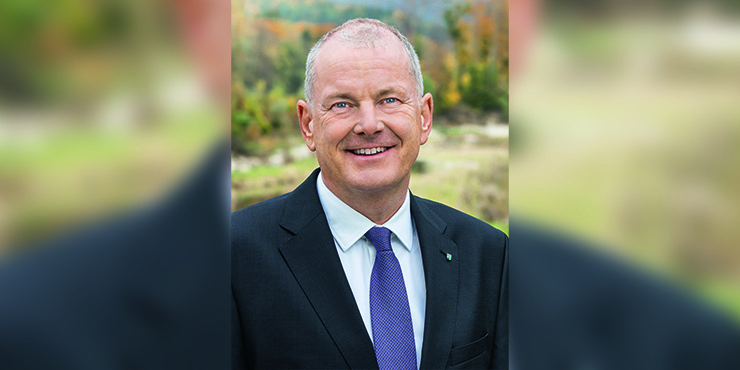"We anticipate a trend towards urban living"

The Aargau government councilor Stephan Attiger speaks about the most important cantonal building construction projects and emerging trends. Inward settlement development and the digitization of construction projects are also important to him.
To person
Stephan Attiger (FDP) has headed the Construction, Transport and Environment Department of the Canton of Aargau since 2013. At the national level, the 54-year-old represents the concerns of the canton as President of the Conference of Construction and Environment Directors (BPUK) and as a board member of the Conference of Energy Directors (ENDK). Born in Baden, he worked for a long time in the management of various Swiss companies before moving into politics. Among other things, he was Mayor of the City of Baden from 2006 to 2013 and Grand Councilor of the Canton of Aargau from 2009 to 2013.
You are in charge of the Construction, Transport and Environment Department of the Canton of Aargau. How do you have to imagine a typical working day for you?
In the last few months, my working days have been rather untypical due to covid: I was often in the home office, physical meetings were rare, and official events hardly took place at all. But not every day is the same, and the process depends heavily on the schedule. Basically, early in the morning I discuss the short-term issues and what is to come in the medium and long term with my closest employees. This is followed by meetings at various levels: government council, department, departments, bilateral discussions and meetings with external parties. In between I study files.
What milestones have you reached in terms of construction so far?
On the one hand, there are numerous larger and smaller buildings that I was allowed to inaugurate – not only in road construction, but also in the environmental sector, such as flood protection and renaturation projects. The latter also have a direct and positive effect on the residential and location attractiveness. In addition, we have created important foundations for the planning and subsequent implementation of mobility projects. With the last revision of the structure plan and the new cantonal mobility strategy mobilitätAARGAU, we want to coordinate settlement and traffic development. It therefore sets specific spatial accents and differentiated goals per room type for the individual means of transport. This in turn affects civil engineering and building construction. As a canton, we also act as a role model.
In what way?
For example, we are promoting more biodiversity and quality of stay in the outdoor spaces of our properties. We are looking for good solutions for how biodiversity issues can be taken into account in new buildings and in the maintenance of existing properties. Climate adaptation measures on buildings and in their surroundings make a contribution to achieving our climate policy goals. Another good example is the new building for the Office for Consumer Protection, in which we want to use wood from the Aargau forests as a sustainable building material.
What are currently the most important construction projects in building construction?
A major project currently underway in the area of cantonal real estate is the new construction of the police building in Telliquartier in Aarau. The units of the cantonal police, which are distributed across numerous locations, are to be brought together here. The building permit is already available. At the end of March, the canton also started the consultation process for the new location of a canton school in Fricktal. The hearings on the aforementioned new building for the Office for Consumer Protection and the project to merge the Aargau IT department into one building in Unterentfelden were concluded. All construction measures are implemented according to the principle of sustainability. During planning, special attention is paid to the gray energy bound in the building, and the time for new user requirements is coordinated with the time of repair.
Aargau has a large number of development areas that could offer space for additional residents. What are the plans here?
The cantonal structure plan designates 21 residential areas with areas that are predestined for high-quality settlement development. These should make a significant contribution to absorbing the expected population growth over the next 10 to 20 years in suitable, easily accessible locations. The areas should not only support the economical use of the soil with an appropriate density, but also become high-quality and attractive residential locations in the interests of sustainable development. This is the task of the municipalities, which determine the appropriate framework conditions and requirements in the land use planning. The canton supports them in this.
Area developments often stumble over traffic problems. Are you actively helping to find a solution?
It is effectively the case that high demands are placed on traffic planning, especially when it comes to site developments. This is because there are many unknowns about future claims. Here, traffic planning must provide a flexible framework in order to be able to react to the various requirements of investors. As far as the canton is concerned, it takes an active part or sets the framework conditions at the interfaces.
The project to extend the Limmattalbahn from Killwangen-Spreitenbach to Baden is currently making waves. What are your arguments to try to change your mind against the opponents of extra time?
The reporting in the media unfortunately gives a distorted picture of the general level of acceptance for this project. In the public hearing, the regional planning associations and all municipalities in the perimeter of the new tram route as well as most associations of the Limmattalbahn approved. The specifically proposed lines also received broad approval. We take the public's reservations that emerged from the hearing very seriously. For example, we have added additional variants for the lines. We will examine these and other objected points in more detail until they are determined in the structure plan and weigh them against the other cantonal interests and with the reservations mentioned.
Urban sprawl is also a problem in Aargau. Did the municipalities make mistakes in spatial development?
It is important to look to the future. In today's inventory, the potential that can be better used for sustainable development should be recognized. The revision of the Spatial Planning Act of 2013 has shown that the development needs of the next 20 years can be covered with the internal development of the settlement, i.e. the use of the existing reserves. We take the containment of urban sprawl very seriously. The 2015 structure plan finally defines the settlement area. The consumption of crop rotation areas has already fallen sharply.
How well or badly does the cross-community cooperation in spatial development work?
The regional planning associations play an important role in this cooperation. You also have to coordinate the municipal land use planning regionally in accordance with the building law. The coordination along the municipal boundaries works.
What does an optimal use of land resources look like for you?
The economical use of the soil is a central concern. Building upwards cannot, however, be unrestricted. The quality of the settlement and the townscape must always be taken into account. And in the case of underground structures, care must be taken to ensure that there is enough space left where large trees can be planted and water can seep away. This is crucial for avoiding heat islands in the settlement area and for the groundwater. Climate change poses great challenges for us. Optimal use of soil as a resource, sustainable settlement development and high-quality residential and workplace areas are not mutually exclusive.
The canton of Aargau is already well positioned when it comes to digitization. What are the future plans in the construction sector?
The digitization of construction projects with Building Information Modeling (BIM) is a big topic for us. We are currently working on around 20 BIM pilot projects. At the beginning of the year, the first master builder submission was put out to tender as part of a pilot project in the invitation process. Our goal is for BIM to be used as standard for project management in all new projects in the civil engineering department from 2025. Astra and SBB have the same “timetable”.
Pandemics have had an impact on urban planning before. Will Corona present urban planners with new challenges in the future?
Our villages and small towns are ideally suited for walking and cycling as places with short distances. This is a very good starting position, even in times of pandemic. In more and more places there is the possibility to work in co-working spaces. In this way, long travel times can be avoided, even if there is little space for home office. Attractive public spaces and easily accessible recreational opportunities are important. These are in great demand, and not just since Corona. I do not believe that this pandemic will completely turn city planning upside down.
According to an analysis by Wüest & Partner, the canton of Aargau has the highest potential for new living space and development areas alongside Geneva, Vaud and Zurich. What will have changed in Aargau in 10 years?
According to our forecast, we will get more attractive living space, especially in easily accessible locations, near train stations, in the centers of our villages and cities. Existing buildings are being converted, some of them are being built. We anticipate a trend towards urban living, not least because of the demographic development. More older people are drawn to central locations where they can benefit from services, short distances and cultural offerings. But living in the country will also remain attractive. Many of the around 100,000 single-family houses in Aargau are being renovated and brought up to date in terms of energy or even replaced by new buildings.
